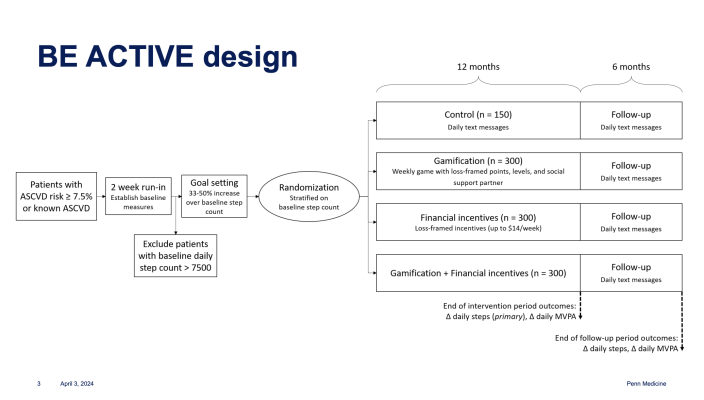
April 7, 2024 — Strategies such as earning points or small amounts of money encouraged people at high risk for heart disease or stroke to increase their daily walking by about 10% and sustain the increase for a year, according to research being presented at the American College of Cardiology’s Annual Scientific Session. The study met its primary endpoint, showing a statistically significant increase in participants’ daily steps from study entry to 12 months.

Alex Fanaroff, MD
“This is one of the largest and longest-duration randomized trials of a home-based intervention to promote physical activity,” said Alexander Fanaroff, MD, assistant professor of medicine at the University of Pennsylvania Perelman School of Medicine and lead author of the study. “Our findings show that interventions based on techniques from behavioral economics can achieve and sustain increased levels of physical activity in a population with risk factors for cardiovascular disease and could be another tool to help reduce cardiovascular risk.”
Behavioral economics is a field that uses concepts from economics and psychology to better understand and influence how people make decisions. Insights from behavioral economics can be applied in many other fields, including medicine and public health, Fanaroff said.
The BE ACTIVE study tested whether certain techniques from behavioral economics could help people increase their level of daily walking. One technique, known as gamification, uses elements of game playing, such as competition and point scoring. Another uses financial incentives, with people gaining or losing small amounts of money based on their behavior.
“We know that physical activity is important for cardiovascular health,” Fanaroff said. “Many studies have shown that people who engage in more physical activity are healthier and have fewer heart attacks and strokes than people who engage in less. This is equally true for people who have previously had a heart attack or a stroke or have heart failure or are at risk for cardiovascular disease.”
Only about 1 in 5 Americans regularly gets 150 minutes of moderate-intensity physical activity per week—the amount recommended by many public health organizations—and that number declines further as people age, Fanaroff said. While the widely publicized advice to get 10,000 steps a day is not based on scientific evidence, he said, studies do show that taking more steps per day—up to about 7,500—can reduce the risk of death from heart disease. In fact, a study published in JACC: Heart Failure found that increasing daily step count was linked to better health status over a 12-week period.
The BE ACTIVE study enrolled 1,062 people with a median age of 67 years, of whom 60% were women and 25% were non-white. One-third had a household income of less than $50,000 per year. All participants either had cardiovascular disease or were at high risk for it. Every participant received a fitness tracker worn on the wrist that automatically uploaded their daily step counts to a secure website.
At study entry, participants’ average daily step count was about 5,000. Each participant was asked to choose whether their goal was to increase their daily step count by 33%, 40%, 50% or at least 1,500 steps more than their level at study entry. Previous studies have shown that when people choose their own goal, they are more likely to achieve it, Fanaroff said.
Participants were then randomly assigned to one of four groups. Those assigned to the control group received daily text messages informing them of their step count the previous day. Participants assigned to the gamification group were awarded 70 points each week. Every day they met their step goal, they retained their points; every day they didn’t meet their goal, they lost 10 points. If they had more than 40 points at the end of a week, they moved up a level; if they had less than 40 points, they moved down.
Participants assigned to the financial incentives group received $14 in a virtual account each week. Every day they achieved their step goal, their balance was unchanged; every day they didn’t meet their goal, their balance was reduced by $2. The fourth group received both the gamification and financial incentives interventions. All participants in the three intervention groups received daily text messages noting whether they did or did not meet their goal the previous day and encouraging them to keep trying.
The intervention continued for 12 months, after which all participants were followed for an additional six months. During the follow-up period participants no longer received their intervention but continued to receive daily text messages informing them of their step count the previous day. The study’s primary endpoint was the change in daily steps from study entry to 12 months. Secondary endpoints included the change in daily steps and average weekly minutes of moderate to vigorous physical activity from study entry to 18 months.
A total of 954 participants (89.8%) completed the entire 18-month study. At 12 months, compared with the control group, mean daily step counts for participants in the gamification group increased by 538 steps more, and in the financial incentives group by 491 steps more. For participants who received both interventions, mean daily step counts increased by 868 steps more than the control group.
At the 18-month follow-up, the group that received both interventions was the only intervention group that had statistically significant greater daily step counts compared with the control group. Nevertheless, in all three intervention groups, compared with their step counts at study entry, participants’ average daily steps increased by more than 1,500 at 18 months and their average weekly minutes of moderate to vigorous physical activity increased by more than 40 minutes.
“The gamification and financial incentives interventions were equally effective, but the combined intervention was significantly more effective than either intervention alone,” Fanaroff said.
No previous fully home-based intervention to promote physical activity lasted longer than 24 weeks or had total follow-up of longer than 36 weeks, he said. Participants’ engagement with the study remained high throughout the study period, he said. “Over the 18-month follow-up period, step counts were uploaded on more than 80% of participant days,” he said.
“In all three intervention arms, we observed an increase in daily steps of about 10% more than control from a baseline of about 5,000,” he said. “We did not collect data on participants’ health outcomes in this trial. However, based on data from observational studies, we estimate that an increase of this magnitude would translate to a 6% lower risk of death from any cause and a 10% lower risk of death from heart attack or stroke, highlighting the clinical relevance of the change achieved in this trial.”
A limitation of the study is that participants voluntarily chose to enroll and may not be representative of all those who were eligible to enroll, Fanaroff said. Secondly, the researchers evaluated physical activity using step counts and minutes of activity but did not assess whether other measures of participants’ health or functional status changed.
The study was funded by a grant from the National Heart, Lung, and Blood Institute, a component of the National Institutes of Health.
This study was simultaneously published online in Circulation at the time of presentation
For more information: www.acc.org


 July 31, 2024
July 31, 2024 









